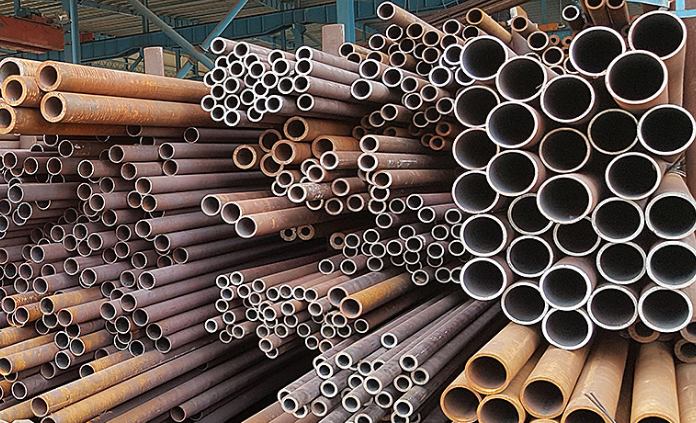
Difference between Carbon Steel Seamless Pipe and Stainless Steel Seamless Pipe
The design rules for stainless steel cannot be used for carbon steel because there are 3 fundamental differences between stainless steel and carbon steel:

The difference between stainless steel and carbon steel 1:
Stainless steel undergoes work hardening during cold working. For example, there is anisotropy when bending, that is, the transverse and longitudinal properties are different. The increased strength by cold working can be used, but if the bending area is small compared to the total area and this increase is neglected, the increased strength can increase the safety factor to a certain extent.
The difference between stainless steel and carbon steel 2:
The shape of the stress/strain curve is different. The elastic limit of stainless steel is about 50% of the yield stress. As far as the minimum value specified in the standard is concerned, the yield stress value is lower than that of medium carbon steel.
The difference between stainless steel and carbon steel 3:
Stainless steel has no yield point, usually expressed as ó0.2, the yield stress is considered to be an equivalent value.
Carbon steel
1. Ordinary steel is carbon steel, that is, iron-carbon alloy. According to the level of carbon content, it is divided into low-carbon steel seamless pipes (to be called wrought iron), medium-carbon steel seamless pipes and cast iron. Generally, those with a carbon content of less than 0.2% are called low-carbon steel seamless pipes (mild seamless pipe), commonly known as wrought iron or pure iron; those with a content of 0.2-1.7% are called steel; those with a content of more than 1.7% are called pig iron.
2. It is usually used on metal parts that require strength, hardness and wear resistance, such as cutting tools, steel cables, piano wires, springs and knives, etc. After being processed, the parts usually need to be processed and tempered. The higher the carbon content of steel, the higher its hardness, strength and wear resistance after heat treatment. Carbon steel is divided into high-carbon steel, medium-carbon steel and low-carbon steel; according to its characteristics, high-carbon steel is hard and brittle, and low-carbon steel is soft and ductile.
a. High-carbon steel with a carbon content of 0.6% to 2% is called high-carbon steel. High-carbon steel refers to steel with a long tempering time and high carbon content. Its main uses are general bearings, knives, rails, steel frame molds (used to shape steel) and steel doors.
b. Medium-carbon steel with a carbon content of 0.3% to 0.6% is called medium-carbon steel. Medium-carbon steel refers to steel with shorter tempering time than carbon steel, moderate carbon content, and properties between high-carbon steel and low-carbon steel. The main purpose is to manufacture stainless steel.
c. Low-carbon steel with a carbon content of 0.02% to 0.3% is called low-carbon steel. Low-carbon steel Carbon steel with a short tempering time, soft, stamping-resistant and ductile, mainly used for manufacturing steel bars, stamping-resistant parts, special steel, etc. The main purpose is to manufacture steel bars, casting materials, construction steel products, steel plates, etc.
Stainless steel
1. The chromium content in steel is more than 13%, and the steel with high resistance to external medium (acid, alkali salt) corrosion is called stainless steel seamless pipe. There are many types of stainless steel seamless pipes, including austenitic stainless steel seamless pipes, ferritic stainless steel seamless pipes, and martensitic stainless steel seamless pipes. Stainless steel seamless pipes are generally not magnetic, but they are not completely correct. Austenite is not magnetic, but ferrite is, but it is relatively weak. Different stainless steel seamless pipes have different ability to resist corrosion, and also have different corrosion resistance to different media.
2. In terms of corrosion resistance. In practical applications, stainless steel seamless pipes have an irreplaceable role for other steel types due to their excellent various properties. For example, there are some high-temperature resistant stainless steel seamless pipes, and stainless steel seamless pipes are widely used for decoration Materials, as well as the excellent mechanical properties of stainless steel seamless pipes make them used in various manufacturing industries.
Permanent Steel Manufacturing Co.,Ltd is a professional manufacturer & exporter of steel pipes in China. Products including carbon steel pipe(SMLS pipe/ERW/LSAW/SSAW),stainless steel pipe, galvanized steel pipe,hollow section and the related products. Products are widely used in municipal engineering, water supply pipes, sewage discharge, heating pipe networks, gas pipe networks, coal mines, ventilation pipes, construction engineering, steel structures, piling, bridge beams, docks and other fields. At the same time, the company is equipped with an anti-corrosion processing plant, which specializes in processing the inner and outer walls of steel pipes.
Go here to learn more about " Manufacturing Process of Stainless Steel Seamless Pipe"


